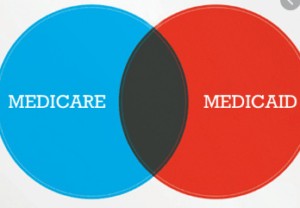Medicaid Or Medicare are actually two different programs even though they sound alike. They are two separate, government-run programs, which are operated and funded by different parts of the government and basically serve different groups.

What is Medicaid?
Medicaid is an assistance program, that serves low-income people of every age. With Medicaid, patients usually pay no part of the costs for covered medical expenses, even though, a small co-payment is sometimes required. Medicaid is a federal-state program, that varies from state to state. It is operated by state and local governments within federal guidelines. To know if you qualify for your state’s Medicaid (or Children’s Health Insurance) program, visit: https://www.healthcare.gov/medicaid-chip/eligibility/
For more details on Medicaid, visit: http://www.medicaid.gov
Medicare
The medicare is an insurance program, whose medical bills are paid from trust funds which those covered, have paid into. Also, medicare serves people who are over 65 primarily, of whatever income range, and serves younger disabled people and dialysis patients. With this program, patients pay part of the costs via deductibles for hospital and other costs. It requires small monthly premiums for non-hospital coverage. Medicare is a federal program, which is basically the same everywhere in the United States and is run by the Centers for Medicare & Medicaid Services, which is an agency of the federal government.
For more details on Medicare and its components, visit: http://www.medicare.gov
Coverage
Medicare
Several parts of the Medicare program offers coverage for various aspects of healthcare
Part A, also known as hospital insurance, is offered without premiums to all individuals who meet the eligibility requirements and have paid or are the spouse of a person who has paid. Medicare taxes for a minimum of 40 calendar quarters in the span of their life.
However, those who are not eligible to receive Part A premium-free may have the option of purchasing it. Also, Part A is also linked with skilled nursing care, hospital services, hospice services, and home healthcare.
Furthermore, part B is the medical insurance portion that offers coverage for outpatient hospital care, physician services, and other such services traditionally covered by health insurance plans.
Part C also referred to as Medicare Advantage, is operated by approved private insurers and includes all the benefits of Medicare parts A and B. These plans may also include other benefits for an extra cost, including dental and vision, and prescription drug coverage.
Part D is operated by approved plans according to federal rules and helps in paying for prescription drugs.
For Medicare parts A and B, sometimes referred to as Original Medicare, it allows many people access to enroll automatically through Social Security when they turn 65. In some cases, you may decide to delay enrollment, maybe because you are still insured through an employer. If that happens, you would sign up manually later on.
For Medicare parts C and D, you can sign up when you first become eligible or sign up during certain enrollment periods each year.
Medicaid
When it comes to Medicaid, the benefits covered by the program, vary by the issuing state. However, there are some benefits that are included in every program.
They include:
- Nursing facility services for adults
- Lab and X-ray services
- Surgical dental services for adults
- Health screenings and applicable medical treatments for children
- Family planning services, like birth control and nurse-midwife services
- Inpatient and outpatient hospital services.
Reimbursement
Medicare
These are payments doctors and hospitals receive for offering services to patients. Medicare reimbursement comes from a federal trust fund and most of the money for this fund comes from payroll taxes. Premiums, deductibles, and copays on the other hand, also help pay for Medicare services.
Medicaid
With Medicaid, many of the specifics vary by state, including reimbursement rates. In situations where the reimbursement rate is much lower than the cost of care, doctors may prefer not to accept Medicaid. This also happens in Medicare sometimes.
Dental and Vision Care
Medicare
Original Medicare (parts A and B) do not pay for most routine dental care, like cleaning or vision care, like an eye examination. However, some Medicare Advantage plans (Part C) will.
Medicaid
Even though Medicaid programs vary by state, they are federally required to include dental benefits for children. While some states offer comprehensive adult dental care, they are not obliged to meet any minimum standard. Also, eyeglasses fall under the list of optional benefits states may decide to cover.
Disability
Medicare
People with disabilities as well as some of their family members may benefit from Social Security Disability Insurance. This program includes Medicare, although in some cases, there is a 24 month waiting period before it begins. To qualify, you are required to have worked and paid Social Security taxes.
Medicaid
The Supplemental Security Income (SSI) program includes Medicaid and makes cash assistance payments to qualifying people with disabilities and those with limited income.
Some people can also qualify for concurrent disability benefits via both programs.
Can you Have Both Medicare and Medicaid?
If you qualify for both Medicare and Medicaid, they you are dual-eligible. When this happens, you may have Original Medicare (parts A and B), or a Medicare Advantage Plan (Part C), and Medicare covers your prescription drugs under Part D.
Medicaid on the other hand may also cover other care and drugs that Medicare does not, thus having both may cover most of your healthcare costs.
from WordPress https://ift.tt/2ITPXgi
No comments:
Post a Comment